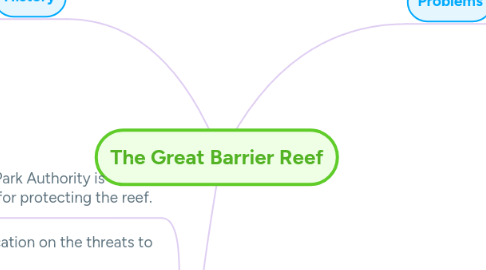
1. History
1.1. The reef is so large it is it's own biome and can be seen from space.
1.1.1. It is a World Heritage Area.
1.2. The reef is about 12,000 years old and until recently has had minimal human presence.
1.3. Consists of approximately 3000 reefs.
1.4. Main tourist attraction, supporting 54,000 full time employment positions.
1.4.1. If the reef suffers, what happens to tourism and employment in the area?
1.5. Habitat to various species
1.5.1. Sea birds, sea life, coral, mollusks
1.6. The reef is central to the culture of the traditional owners.
1.6.1. Indiginous people
2. Prevention
2.1. The Marine Park Authority is responsible for protecting the reef.
2.1.1. 'Reef Water Protection Quality Reef Plan'
2.2. Continuing education on the threats to the reef.
2.3. Re-inforce simple, common sense rules such as 'Place litter in the bin' etc.
2.4. Reef sharks could increase reef resiliance. Monitor the fishing of these sharks.
2.4.1. Other fishing within the reef is restricted.
2.5. Re-zoning of areas to help protect habitats.
2.5.1. The placement of reef moorings and protection markers.
3. Problems
3.1. Climate Change
3.1.1. Coral bleaching from rises in water temperature.
3.1.1.1. Sends 'negative' messages about the reef and could reduce tourism .
3.1.2. Severe storms
3.1.2.1. Flooding, cyclones
3.1.2.1.1. Impacts the tourism industry
3.1.2.1.2. Destroys the reef
3.2. Excessive Tourism
3.2.1. Dropping anchors and fuel from boats
3.2.2. Suncreen and sweat run off from swimming tourists
3.2.3. Litter
3.2.4. Reef Walking
3.3. Coastal Development
3.3.1. Decreasing wetlands
3.3.1.1. 'The Great Barrier Reef Coastal Wetlands Protection Program'
3.3.2. Increase in shipping
3.4. Threatened Species
3.4.1. Dugong
3.4.2. Sea Birds
3.4.3. Marine turtles
3.4.3.1. Getting caught in trawl nets
3.5. Over-fishing
3.5.1. Declining numbers of reef sharks which has been linked to reef health.
